BIG OUTBOARDS GET EVEN BIGGER
It wasn’t so many years ago that 200hp was a big outboard. Then along came the 225, the 250, 275, 300 and in 2007 Yamaha released the first 350hp production outboard onto the market. This month Yamaha have put their stamp on the big outboard market again with the first production outboard over 400hp, the XTO Offshore 425.
But while all this is going on with the mainstream Japanese and US outboard manufacturers, an American company, Seven Marine threw the rule book out and produced a 627hp monster. But wait there’s more. While the petrol heads were getting their fix of horsepower, an English company, Cox Powertrain dropped a 300hp diesel into the mix.
If you are in the market for an outboard over 300hp (or multiples of), then you have seventeen to choose from. Cox has just the one engine at present but no doubt there will be more to follow. Evinrude also has one with the 300 G2 and Suzuki, Yamaha and Seven Marine have three apiece. Mercury leads the pack with six engines. But then Mercury has always been active at the high-performance end of the market, a by-product of a bygone era in the 1970s when the horsepower race was very much a battle between Mercury and OMC.
BRAGGING RIGHTS

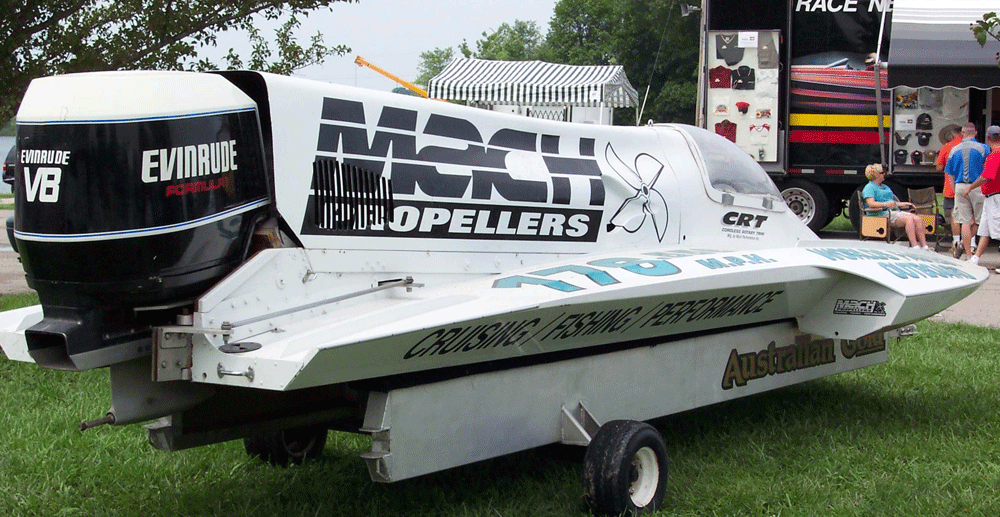
The ’70s was an era of outboard factory racing where Mercury battled Outboard Marine Corporation (parent company of the Johnson and Evinrude brands at the time) for bragging rights across the globe.
They fought head to head at every race and none more so than the European ON/OZ tunnel boat circuit. The ON class had a maximum engine limit of 2 litres and OZ was over 2 litres, with no limit to the size of the cylinder volume.
They were the golden years of tunnel competition when winning prestigious events such as the 6-hours of Paris or 3-hours of Amsterdam had a direct impact on European outboard sales.
1973 was the magic year when both OMC and Mercury introduced the V6 in the famous Paris race for the ON class. OMC purpose built their new 2 litre V6 from scratch. It was a cross flow design and because of the two-litre limit, OMC could not just add two more cylinders to the famous Super Strangler/Stinger GP V4.
Mercury turned out with an all-new V6 that would become known to the world as Black Max. The engine earned its stripes winning races for a good two years prior it’s 1976 public debut. Mercury Racing produced many competition outboards based off the V6 platform.
This was also the year that Mercury Racing was established as a division of Mercury Marine. Known as Mercury Performance Products at the time, its sole responsibility was product development and promoting Mercury’s image through racing. Something that they have successfully continued to do for 45 years. Mercury Racing was established as a business unit of Mercury Marine in 1992.
In 1976 OMC released the new V6CCC, a 2.448 litre cross flow engine that was based on a standard production 200hp V6, but on a short column and with some very highly tuned additions that allowed it to run to 7200rpm.
They followed this in 1978 with a brand new purpose built 3 litre looper V6 with fuel injection. This engine was also called CCC but was an entirely different animal from the first CCC. Then in 1981 OMC introduced the baddest of them all, a purpose V8 race engine.
The 555lb, eight carbs 3.6-liter two-stroke V8 engine (3.6 GT and 3.6 XP) were officially 275-hp engines, but lore suggests that the engines made at least 300 hp at the prop at 6250 rpm. Like all two-strokes, they liked a lot of fuel-91 octane in this case-and they liked to run wide-open, making them unsuited for most recreational users. What they were good for was speed.
Also like all two-strokes, the 275 responded well to tuning, and in 1989, a 10,000-rpm, methanol-burning Evinrude V8 (est 600hp) set a 176.556-mph world record for outboards. A record that still stands a quarter-century later. In 1988, the 275s were enlarged to become the 4.0-litre GT and XP 300 V8s, which were produced through 1995, along with occasional 275 and 250 variants. In time the racing V8 was available to the public in a recreational mode, but it never proved popular. It was big, heavy and not that reliable. The V8 two-stroke was killed for a bunch of reasons, the most significant being the introduction of fuel injection, which made the same power possible from a much smaller V6, as Mercury soon proved.
But by any standards, the OMC V8 300s were beasts.
YAMAHA BREAKS THE 400 BARRIER
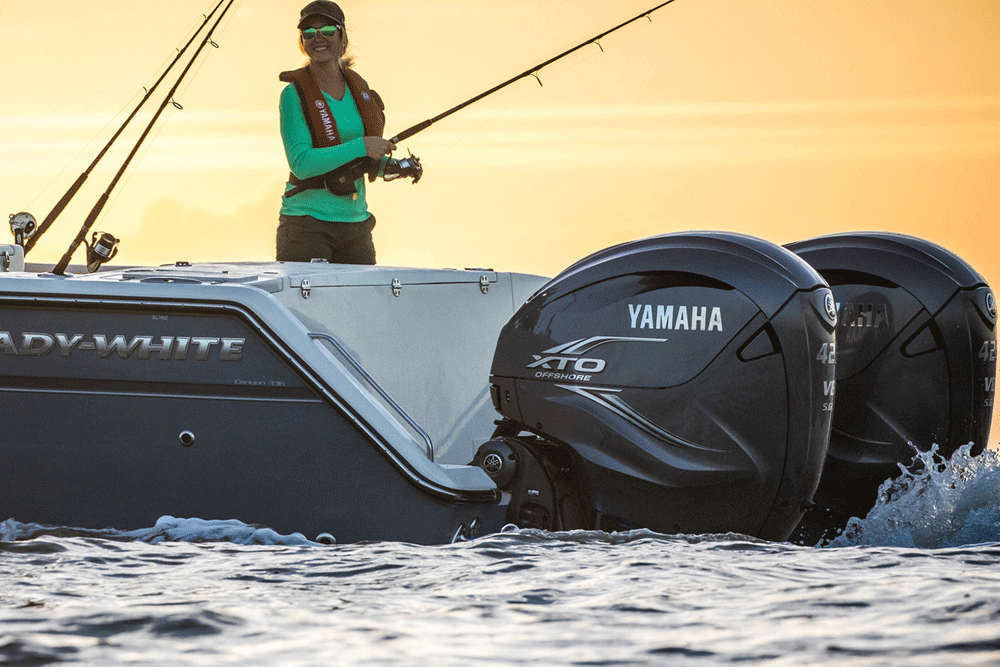
The V8 didn’t get reintroduced back into the market until 2007 when Yamaha brought out the 5.3 litre F350. Unlike the OMC V8, which was 2-stroke, the Yamaha F350 was the world’s first V8 4 stroke outboard. The OMC V8 weighed in at 250 kg, with the F350 a much heavier 365 kg. Also as opposed to OMC, it was never intended for racing. The F350 was designed to provide massive thrust for the heaviest off-shore outboard-powered boats.
The motor is a double overhead-cam 60-degree V8, displacing 5330cc. It features variable valve timing, ionic combustion sensors, a new anti-corrosion system, massive forged motor mounts and transom bracket.
It was the first Yamaha outboard to feature a digital drive-by-wire throttle and shift control. Yamaha says the motor’s astounding weight is a result of its desire to make the F350 extremely durable, and reliable enough to take far off-shore. When it comes to 300hp, Yamaha has an award winning F300 in its stable. It shares the same V 6 4.2 litre block used for the F250 and F225 and comes with all the latest technology from Yamaha. They all share the advanced 24-valve DOHC engine with features such as EFI as well as VCT (Variable Camshaft Timing). Combining technology with style, the sleek, compact design is one of the lightest in its class, has one of the smallest displacements and comes with a high output 70 amp alternator.
Now they have upped the ante with the all-new 425 horsepower, Yamaha XTO Offshore. This beast of an engine has been designed from the ground up to deliver maximum power and thrust. Powered by a big bore, 5.6 litre, naturally aspirated engine, the XTO Offshore opens up a whole new class of large outboard driven boats. The XTO Offshore is not only the most potent outboard ever produced by Yamaha, but it is also their most technologically advanced, with the introduction of Yamaha’s first fully integrated power system.
This system combines a revolutionary fully integrated electric steering system, with their premium CL7 multifunction display, advanced ‘drive-by-wire’ throttle controls and Helm Master joystick docking and positioning controls – creating a truly effortless boating experience. Other key features include an in-water gear lube change system, oversized rugged gear case and hardened gears, massive 90 Amp power-generation system and large diameter XTO OS high thrust prop.
The Yamaha V8 is available in 25″, 30″ and 35″ shaft lengths.
MERCURY ENTERS THE V8 PARTY
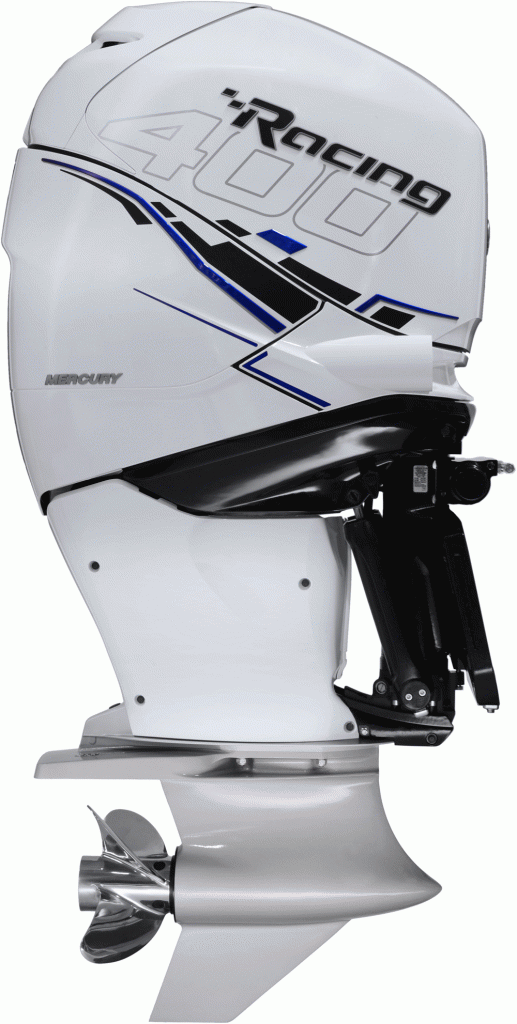
In 2018 Mercury joined the V8 outboard fraternity, but interestingly they have not chosen (yet) to bring their new engine out in the larger horsepower market. The multiple new 4.6L V-8 Pro XS outboards are only available from 200-300hp.
The new 200-300hp Pro XS models are built on a 4.6L quad-cam powerhead that delivers excellent torque while weighing just 229 kg, making them the lightest V8s on the market. They are even lighter than their inline 6 Verado engines.
The 200-300hp Pro XS Four Stroke models also feature a robust 1.25-inch diameter prop shaft and are available with a next-generation Torque Master gearcase, that offers a 1.75:1 gear ratio and low-water pickups on the nosecone for added mounting and trimming flexibility.
The new four-stroke offer consumers choices between mechanical or digital (DTS) controls and hydraulic or power steering. The engines are also available in multiple colours and can be further customised with the addition of an accent panel.
The next-generation outboard engines are part of the most extensive single new product development program Mercury has undertaken in its nearly 80-year history, prompting a significant investment in expanding its manufacturing footprint.
To cater for the high performance boaties, who find 300hp a bit tame, Mercury offers two engines; the 350 Verado and the 400R. Both are based on a 2.6 litre six-cylinder inline-block, which is supercharged with charge air cooling and electronic boost pressure control. The Verado engine platform stems back to 2004 when it was released in 200/225/250 & 275 configurations. Today the Verado is available in 250/300/350 & 400 hp.
Mercury’s in line 6 Verado engine was the first production outboard to embed a supercharger into the motor! The centrifugal supercharger is cooled via an active air intercooler that is designed to inject boost air that is the exact same temperature as pure intake air.
SUZUKI JOINS THE 350 CLUB
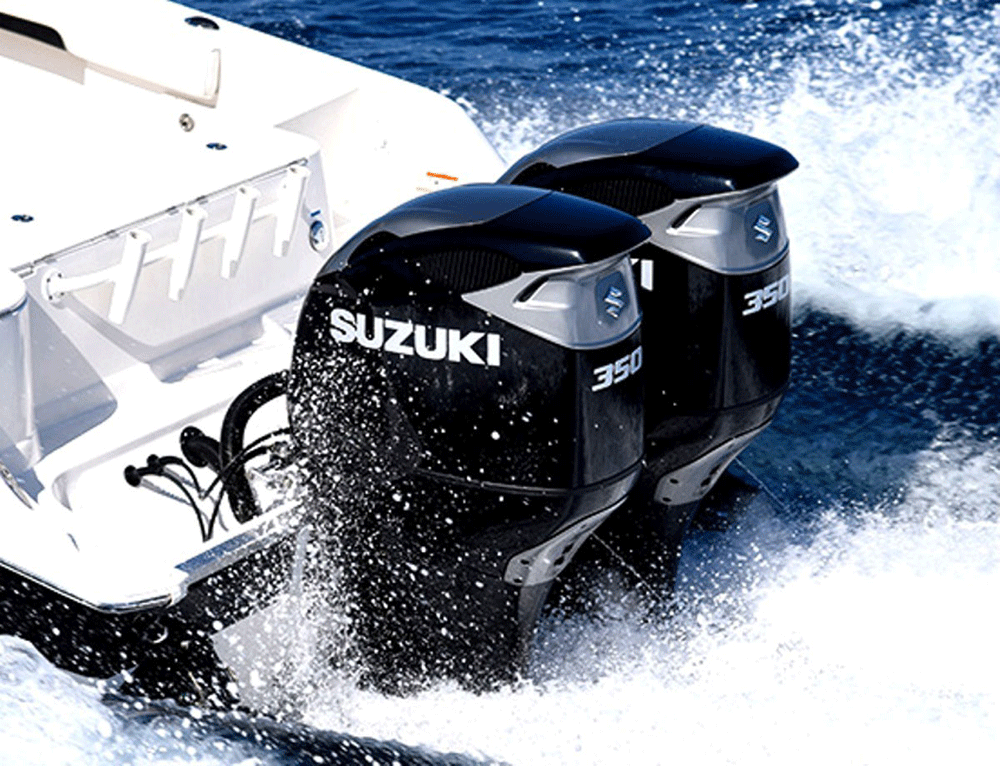
In 2017 when Suzuki released the DF350A, they were the third outboard manufacturer to offer a 350 hp outboard, joining Mercury’s 350 Verado and Yamaha’s F350. With this motor, Suzuki, like its competitors were looking for a slice of the US offshore centre console market with triple and quadruple outboards.
To make their mark in this competitive area, Suzuki needed to do something different and they did that with the very innovative pair of contra-rotating three-blade propellers. This helps boost holeshot, minimises prop torque, grips better in tight turns, and improves low-speed handling in forward or reverse. Contra-rotating props also negate the need to mix right and left hand rotating motors in multi-outboard installations.
The contra-rotating props also help distribute torque across two inline gears that are smaller in diameter than would be necessary with a single prop. This helps keep the gear case as small and hydrodynamic as possible to reduce drag, increase efficiency and boost top speed. Suzuki engineers also repositioned the primary cooling water pickup to the front of the bullet, with a secondary pickup on the underside, just forward of the skeg.
To increase the power output of the 4.4-litre block (up 0.4 litres from the existing Suzuki 300), the engineering team increased the compression ratio to 12:1.
The new 350 carried over many features of the 300, (released in 2006) including electronic throttle and shift for smoother control, Lean Burn to maximise fuel efficiency and two-gear reduction to help keep the gear case compact.
Suzuki’s newest addition to the big engine market is the DF325A, released in early 2018. One of Suzuki’s prerequisites when designing the DF325A, was it had to be able to run on 91 RON fuel.
It is essentially the DF350A de-tuned and features all the same innovations such as a dual prop system, dual injection, 2-stage gear reduction and variable valve timing.
SEVEN MARINE IS TOTALLY AWESOME
When it comes to bragging rights, Seven Marine is way out on their own. No one even comes close! Designed as an ultra-high performance outboard for the US sports boat market, the Seven Marine engines offer a whole new dimension to the way we see outboards and despite a horrendous price tag, they are finding plenty of transoms. Plus most of those are multi rigs, up to four or even five on some offshore centre consoles in the US.
Seven Marine, based in Florida, are the pioneers of extreme horsepower outboard marine engines. Entering the market in 2010 with the 557, which was the largest outboard at the time, this highly innovative company continues to push the boundaries in outboard technology and innovations.
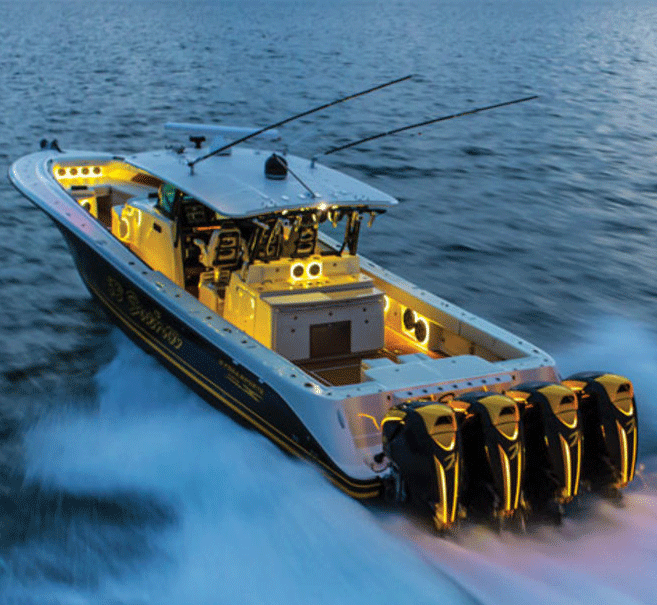
Within five years Seven Marine had already produced an even bigger engine than their initial offering. The 627SV was unveiled at the 2015 Miami International boat show and now there are three Seven Marine Engines available; the 527, the 557S and the 627SV. When it comes to bragging rights, Seven Marine is way out on their own. No one even comes close! Designed as an ultra-high performance outboard for the US sports boat market, the Seven Marine engines offer a whole new dimension to the way we see outboards and despite a horrendous price tag, they are finding plenty of transoms. Plus most of those are multi rigs, up to four or even five on some offshore centre consoles in the US.
Seven Marine, based in Florida, are the pioneers of extreme horsepower outboard marine engines. Entering the market in 2010 with the 557, which was the largest outboard at the time, this highly innovative company continues to push the boundaries in outboard technology and innovations. Within five years Seven Marine had already produced an even bigger engine than their initial offering. The 627SV was unveiled at the 2015 Miami International boat show and now there are three Seven Marine Engines available; the 527, the 557S and the 627SV.
The Seven Marine engines have only recently been available in New Zealand and Australia and attracted huge attention. The basis of the trio of engine packages; 527hp, 577hp and the 627hp, the highest horsepower outboard on the planet, is the 6.2-litre supercharged V8 GM LSA Gen 4 engine, which can also be found under the hood of high-performance Cadillac automobiles.
With a goal of broadening the torque band to better power heavier boats, Seven Marine has modified the cylinder heads to create more turbulence in the combustion chambers. The result, according to Seven Marine, is a gain of about 50 foot-pounds of torque – the 627 pumps out 600 foot-pounds from 3000 rpm to WOT at 5500 rpm – and 70 more at peak horsepower. And it makes that power on 89 octane fuel.
The fact that each Seven Marine outboard weighs more than 545 kg does not seem to be an issue on really big boats. Seven Marine now offers a twin-prop CR gear case to provide the blade area required to move heavier boats, in addition to its standard case (good for 80 mph) and a crescent-shaped GT gear case for those looking for even more speed.
Seven Marine outboards are offered in fabulous custom paint, to match the equally fabulous finish of the boats they would power. Seven Marine has added another level of flash with its SpectraBlade cowl, a revised shape that incorporates strips of diffused LED lighting that can be adjusted to produce just about any colour imaginable.
COX OFFER 300HP OF DIESEL POWER
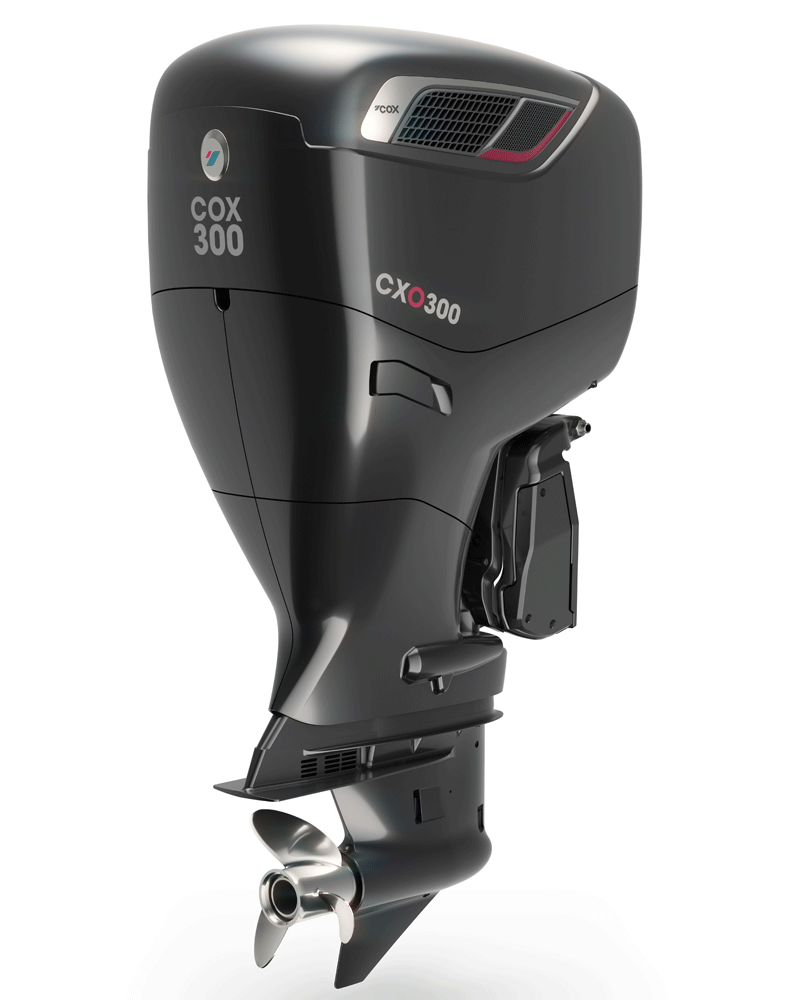
In November this year, British diesel engine innovator, Cox Powertrain, will be opening the order books to distributors for one of the marine industry’s most talked about engine developments. The CXO300 is the world’s highest power density diesel outboard engine and has been developed for commercial and military users of multiple applications and will be a game-changer for the marine industry.
The launch of the high powered 300hp diesel outboard follows an intense ten-year development programme following an initial contract win from the British Military of Defence to develop a new concept diesel outboard for use on its fast response navy vessels.
The final engine concept is based on a 4-stroke, V8 architecture which will offer users higher fuel efficiency, greater range, higher torque and substantial total cost of ownership advantages.
The CXO300 has 100% higher peak torque at the crankshaft than the leading petrol 300hp outboards, 60% higher when compared with a leading 350hp and this difference is amplified when looking below the mid-range rpm. The increased low-end torque will push heavy loaded hulls through rough waters with less strain on the engine and improve even further the fuel performance in comparison to similar petrol outboards, which are notorious for their lack of low-end torque. Larger vessels will also benefit from the higher torque curves, both at the low end and the high end.
The engine offers fuel savings of approximately 25% in comparison to a similar 300hp petrol outboard, allowing boaters to go that much further. The CXO300 is also designed to have a lifespan two to three times longer than current outboard engines and to ease the servicing process by allowing a “dry” service every 1000h or once a year, whichever comes sooner.
NATO’s single fuel policy, which aims to cut the use of petrol-driven equipment in favour of diesel engines, is also a significant factor for many operators and the introduction of a viable diesel outboard, such as the CXO300, will be transformational for professional users of fast response vessels.
Cox says users of the CXO300 could save up to 45% over the lifespan of the outboard, based on heavy use of 6,000 hours with an overhaul at 3,000 hours.
EVINRUDE ETEC MOST POWERFUL 2-STROKE
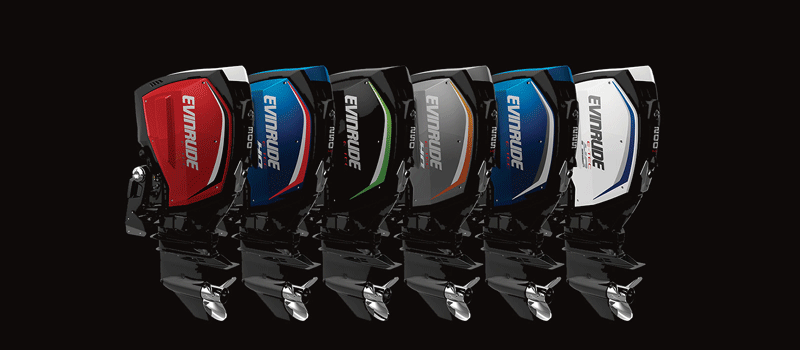
Evinrude has bucked the trend somewhat and has not followed the four-stroke path, preferring to stay with the direct injection two-stroke platform. The biggest of these is the E-Tec G2 300.
It was June 2014, when BRP took the shroud off of a secret project that was five years in the making, the Evinrude E-Tec G2 series. The range now consists of ten engines from 150hp-300hp.
BRP claimed that their new G2 outboard would deliver a 15% fuel economy improvement by being more efficient in changing fuel into energy. At W.O.T. the 300HP V6 74° E-TEC direct injection G2 outboard burns 79.5 lph, burns 2-3 times less emissions than their competitors and produces the lowest levels of carbon monoxide (CO) of any outboard currently on the market. Despite being a two-stroke outboard, the G2’s are 100% emission complaint globally.
The G2 outboard features a distinctive piston thrust away from the hot exhaust port, which leads to increased durability and produces 20% more torque (over 600 foot pounds at 5,000-6,000 rpm). Other features of the G2 include a titanium oxide coating on all aluminium parts, a lightning-fast microprocessor with failsafe protection mode, an auto break-in period, and an auto-storage function.
One of the very cool features of the Evinrude E-Tec G2 is the customisable colour choice. The G2 is available with 14 different swoosh colours for the accent, matched with two standard colours (black or white) and the three optional colours of red, silver or blue, producing over 400 customisable colour combinations in all. Now your outboard can look custom matched to your boat graphics.
Evinrude offers a 5-year warranty as well as a 5-year non-declining corrosion coverage and no dealer-scheduled maintenance is required for five years or 500 hours of operation.




